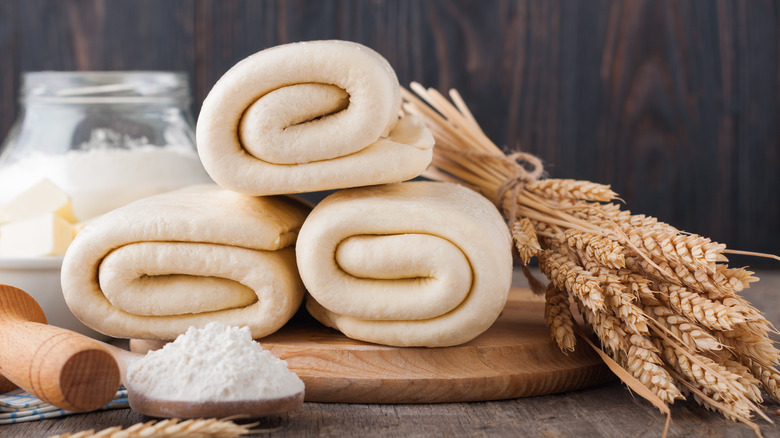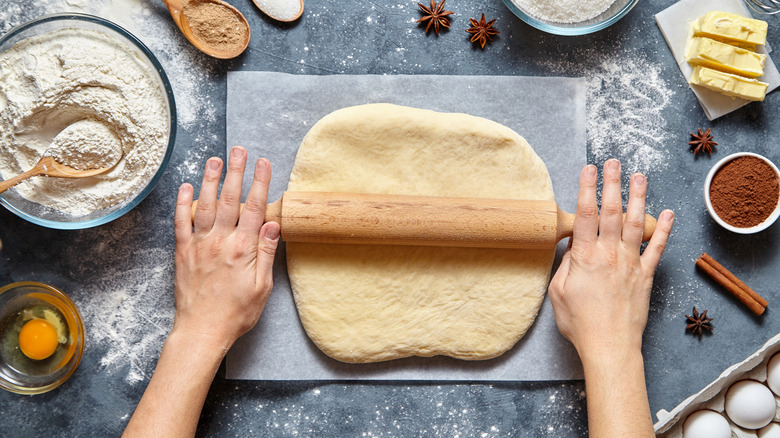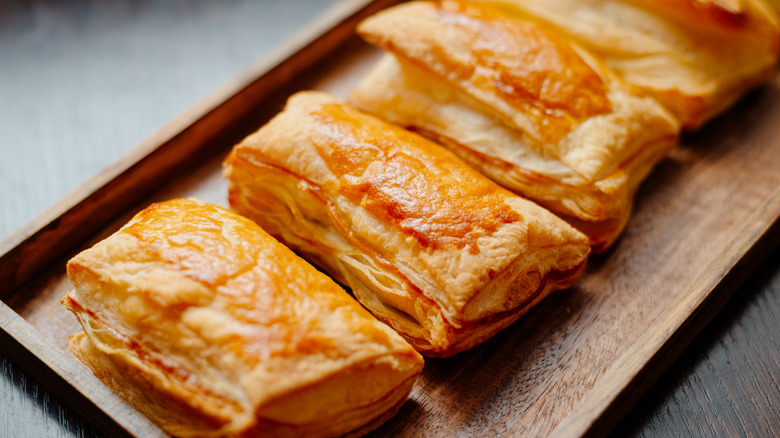The Common Rolling Pin Mistake That Deflates Puff Pastry
As the flaky, crispy foundation of virtually every tasty baked good, from apple turnovers to sausage rolls, puff pastry, or pâte feuilletée, is a treat for the senses. At least when it's made properly. With its earliest recipe dating back to 17th century France, this light, flaky pastry is made from a laminated dough. The process of lamination is integral to its texture and involves placing butter (or shortening) inside the dough and then folding it in. After plenty of rolling, folding, chilling, and rolling some more, you'll be left with layers upon layers of butter and dough. The end result: A delicate and delicious paper-thin pastry.
But if you're an avid baker or a diehard fan of "The Great British Bakeoff," you know how tricky puff pastry can be to make and work with — even the frozen store-bought kind. As the pastry dough has quite a high fat content, it's particularly sensitive to temperature; you don't want the butter to be too soft or too firm when rolling out the pastry or before baking it. Additionally, how puff pastry is handled can affect how puffy it ends up once out of the oven. To prevent your golden-brown flaky pastry from deflating while baking, you'll want to be cautious when wielding your arsenal of essential home baking tools — particularly your rolling pin. So what's the common mistake many home bakers make with puff pastry? Rolling over the edges of the carefully layered dough.
Avoid rolling over the dough's edges
If you've ever eaten a savory vegetable tart, you can likely recall its texture fondly. The layered pastry may have been tall yet airy, delicate yet crispy (but not crunchy, as the two textures are actually rather different). The first buttery bite may have even practically melted in your mouth. This symphony of sensations is thanks to the lamination process of puff pastry dough, namely how baking affects it. With butter thoroughly layered into the dough, something magical happens in the hot oven. As the puff pastry bakes, the water in the butter is heated to the point of steaming. The steam rises and creates space between the layers, leading to the signature puffiness.
However, it's important that the steam has space to rise and eventually dissipate. This is where careful use of a rolling pin comes into play. While rolling out the dough is an essential part of shaping and sizing it for your baked goods, when done a certain way, it can prevent the pastry from properly puffing up. The key is to avoid rolling over the edges of the puff pastry sheet. This common mistake can result in the edges being flattened and pressed shut. Rolled edges can stop the layers from separating and puffing, taking the air out of your pastry and the wind out of your sails as a baker.
Temperature also affects how puffy the pastry gets
Whether you're making homemade puff pastry or working with store-bought dough, there are other steps worth taking to ensure your pastry turns out perfectly crispy and puffy. As mentioned earlier, temperature plays a crucial role in texture, too. The star of the show in puff pastry, butter is a fickle but practically universal baking ingredient; one that's oddly most efficiently softened when the sticks are standing upright. Fortunately, managing its consistency in this case is as simple as keeping the dough cold.
Puff pastry made from scratch requires several stages of chilling during the dough-making process. Naturally, the refrigerator (rather than the freezer) will become your best friend. Each stage of folding and rolling is followed by about 10 minutes of resting in the fridge to prevent the butter from melting. If you're working with pre-made puff pastry that started in the freezer, you'll also want to re-chill it in the fridge before it goes into the oven. Otherwise, the butter may become too soft. This will cause it to be absorbed by the dough instead of evaporating; the pastry's layers won't puff up. Instead, butter will ooze out during baking, resulting in a soggy pastry rather than a crisp one. No baker wants that, which is why the excruciatingly hot tent on "The Great British Bakeoff" is such a precarious place for pastry-making. Hopefully, your kitchen will be comfortably cool in comparison — and your refrigerator and rolling pin will be friend rather than foe as you take on puff pastry.


